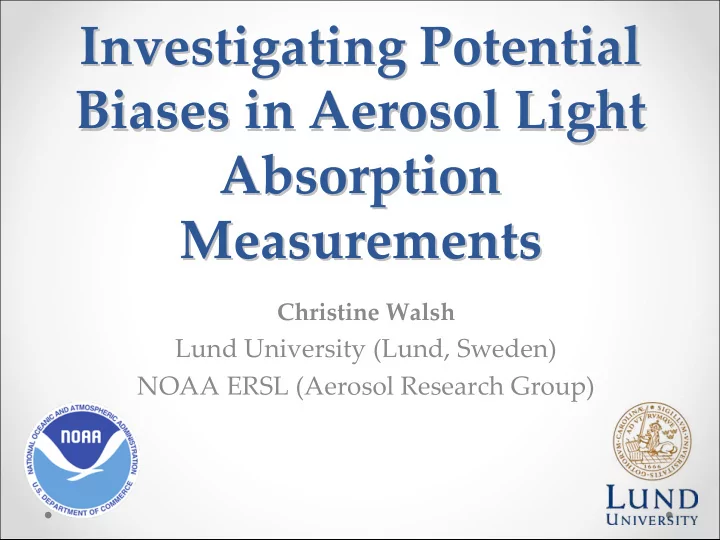

Investigating Potential Investigating Potential Biases in Aerosol Light Biases in Aerosol Light Absorption Absorption Measurements Measurements Christine Walsh Lund University (Lund, Sweden) NOAA ERSL (Aerosol Research Group)
Overview of Presentation Overview of Presentation • Brief Introduction o Why study Atmospheric Aerosol Absorption? o Measurements of Aerosol Absorption o Potential biases in measurements • CalNex: California Air Quality and Climate Nexus • STORMVEx: Storm Peak Laboratory Cloud Property Validation Experiment • Conclusions
Why Study Aerosol Absorption? Why Study Aerosol Absorption? • Absorbing aerosols are most often from primary sources; soot created during combustion processes o Modified in the atmosphere when other species react/condense upon them Absorbing aerosols are of climactic importance due to their • contribution to atmospheric warming o Black carbon (BC) said to contribute up to 20‐50% as warming by CO 2 (IPCC, 2007) • When found within cloud cover, the absorption of light by aerosols causes the instability and dissipation of clouds o Absorbing aerosols contribute to the warming of the atmosphere • However, as the fraction of light that is absorbed by aerosols is typically smaller in magnitude compared to scattering by aerosols, accurate measurements remain a challenge in practice
Measurements of Aerosol Absorption Measurements of Aerosol Absorption • Currently, no instrumentation that offers reliable measurements, simplicity in use, and reasonable cost as a single entity Instruments for more exclusively for intensive field campaigns o can be expensive and complex in operation, but more accurate and precise • Photoacoustic Spectrometer (PAS) • Cavity Attenuated Phase Shift (CAPS) extinction monitor – Integrating nephelometer (difference method) Those intended for long‐term monitoring within a network need o to be affordable and simple to operate, but may yield less accuracy and precision • Filter‐based instruments‐ Particle Soot Absorption Photometer (PSAP)
Potential Biases in Potential Biases in Measurement Measurement • Filter ‐ based techniques can result in measurement biases under some conditions • Possible discrepancies were investigated using a subset of measurements from two field campaigns 8 flights over California during CalNex field o campaign (April ‐ May 2010) • PSAP and PAS Data from STORMVEx at Storm Peak Laboratory in o Steamboat Springs, CO (January ‐ June 2011) • PSAP and CAPS ‐ Nephelometer (Difference Method)
Figure 1: Flight tracks of the 8 CalNex flights utilized in analysis. Of the 8 flights, 5 were concentrated within the Los Angeles region with 3 flights outside of this area. Flight times varied by scientific aim.
CalNex Results CalNex Results Figure 2: Time series example of data collection in by the PSAP and PAS for a segment of the June 16 th , 2010 (DOY 167) flight. Both instruments follow closely in shape and magnitude of absorption coefficient ( σ ap ) measurements.
Potential Bias due to Organic Aerosols Potential Bias due to Organic Aerosols Figure 3: Ratio of the PSAP absorption to the PAS absorption (R abs ) as a function of the level of AMS OA mass concentration for all flights (left) Counterpart figure from the Lack et al. (2008) (right) Houston investigation shows the observed filter ‐ based bias as OA levels increased above 12.5 μ g m ‐ 3
Los Angeles Metro Region Investigation Los Angeles Metro Region Investigation Los Angeles Figure 5: Map of the defined Los Angeles, California metro region utilized in analysis. Boundaries were defined to include as much populated area as possible, while minimizing the amount of included ocean area. Area photo obtained from Google (public domain)
Figure 6: Regression of the PSAP and the PAS for measurements obtained within the defined Los Angeles metro region Levels of OA are distinguished to better associated R abs values with associated OA concentration
Figure 7: Regression between the PSAP and PAS during flights within the LA metro region during the day (top) and night (bottom) flights Bias to the filter ‐ based PSAP appears (top), suggesting potential differences in day versus night σ ap measurements
Figure 8: Regressions of the PSAP and the PAS for daytime flights over the LA metro region. A bias to the filter ‐ based PSAP appears on May 19 (DOY 139; right), but is not apparent on June 20 th (DOY 171; left). This difference indicates other factors of influence must be considered to determine cause of bias.
STORMVEx STORMVEx Storm Peak Laboratory Storm Peak Laboratory
STORMVEx Results STORMVEx Results Figure 9: PSAP and CAPS ‐ Nephelometer σ ap measurements Difference method σ ap noisier than PSAP During high aerosol loading (>20 Mm ‐ 1 ) event (DOY 90 ‐ 120): measurements track very well Ratio of Absorption appears to improve (i.e. shifts closer to unity) after DOY 90 No evidence of filter ‐ based bias in this campaign
Conclusions Conclusions • CalNex: o Bias attributed to high OA levels observed in the Lack et al. (2008) Texas campaign did not result in a similar bias in the CalNex flights o However, bias was observed for a single daytime CalNex flight o Further inferences could have been made on whether the potential organics bias is related to the age and oxidation ‐ level of the sampled aerosol, had separation between OOA and HOA been available • STORMVEx: o Good Agreement in absorption measurements during period of high aerosol loading event o No apparent bias of filter ‐ based measurement
• Why important? • Could have implications in further research which aims to make observations with filter ‐ based instruments in high OA regions Source: Zhang et al. 2007
Thank You for your Thank You for your attention! attention! Any Questions? Any Questions?
Recommend
More recommend